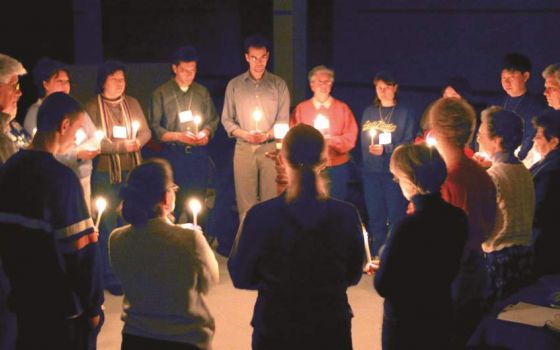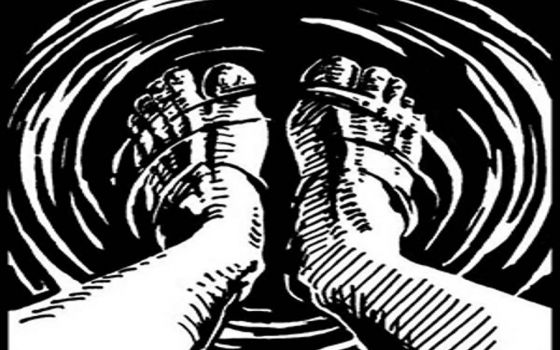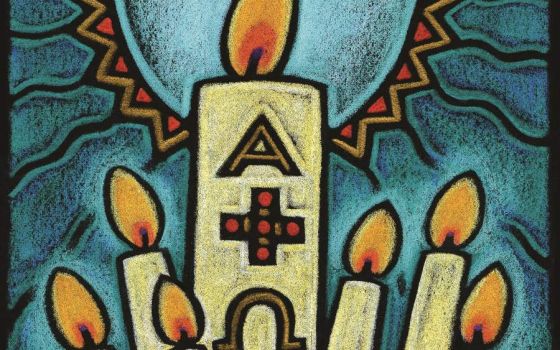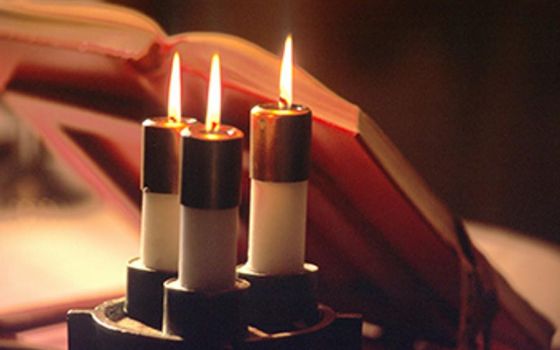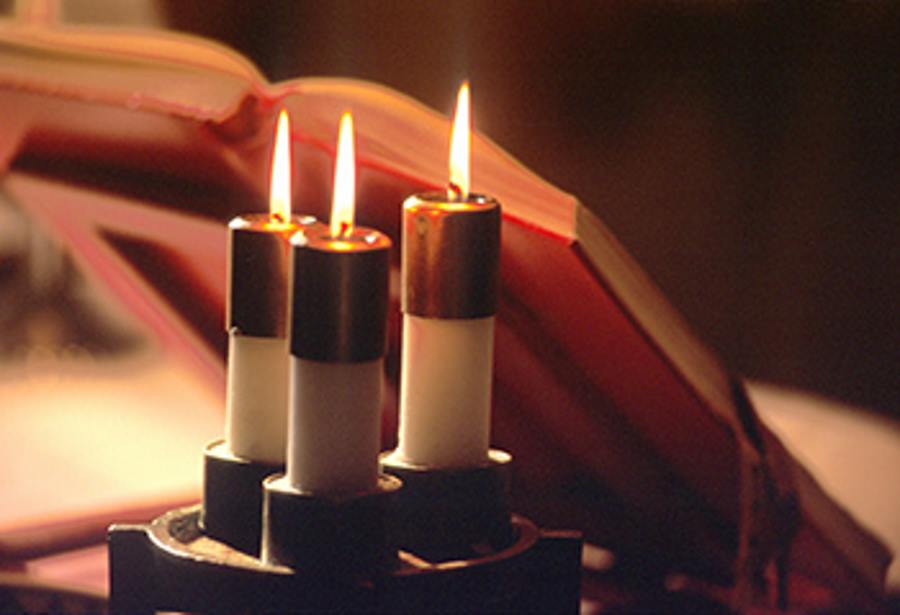
(Photo by Bill Wittman)
The sacred Triduum is the highpoint of the liturgical year. These three days proclaim the paschal mystery which defines who we are as Christians. The readings in the Lectionary are rich and complex. They offer numerous perspectives from which to approach this profound mystery. The preacher or catechist may struggle to find direction in this abundance of possibilities. One path to assist the journey moves us in three steps: enactment, choice and promise.
Holy Thursday: Enactment
God has saved us in Christ. This is the Gospel. The sacred Triduum remembers the saving action of the death and resurrection of Jesus. But the first step of the Triduum is not to describe Christ's action but to emphasize how it continues. Before we reflect on the cross and empty tomb, we recognize how the effects of Jesus' dying and rising continue to shape our lives.
The Exodus relationship through a meal
The first reading at the Evening Mass of the Lord's Supper is from Exodus (12:1-8, 11-14). It does not describe God's mighty deed of the Exodus which grounds the Jewish experience of God. (That story of the Exodus is told at the Easter Vigil.) The passage heard on Holy Thursday describes how Israel remembers the Exodus and its relationship to God through a meal — a meal to be repeated time and again. As the closing verse of the reading states: "This day shall be a memorial feast for you, which all your generations shall celebrate with pilgrimage to the Lord, as a perpetual institution." Each time Jews gather to share the Passover meal they do not simply remember what happened at the Red Sea. They symbolically enact the event — not in the sense of repeating the historical crossing through the waters, but by allowing the effects of that crossing to impact their lives.
The Exodus shaped Israel into a people. Every time they celebrate the meal recalling the Exodus, Jews assert they are still a people and God is still their God. The enactment of the Passover meal allows the presence of their saving God to continue in the lives of a living people. The Passover is a "perpetual institution" because the meal enacts the perpetual love of God.
Do this in remembrance
As in most things Christian, our practice follows the pattern of our Jewish brothers and sisters. So it is no surprise that in the second reading of Holy Thursday, Paul describes the meal by which the saving action of Christ is enacted. This account from 1 Corinthians is the earliest testimony of Jesus' action at the Last Supper (1 Corinthians 11:23-26). Jesus links his body and blood to bread and wine. His intention is clear: "Do this in remembrance of me." Like the Passover meal, this meal of Jesus is to be a perpetual institution. Paul does not want us to miss the point. He tells us, "For as often as you eat this bread and drink the cup, you proclaim the death of the Lord until he comes." Proclaiming the death of the Lord is more than remembering Jesus' crucifixion. As we share the meal that Jesus left us, we enact the paschal mystery — not in the sense of repeating Jesus' death and resurrection but enabling its effects to transform us.
The significance of the meal in John
The first two readings of Holy Thursday point to the power of meals to enact God's saving action in the lives of subsequent believers. The Gospel passage presents what is enacted. The passage is from the Last Supper scene in John's Gospel (13:1-15). Unlike the synoptic Gospels, John gives no account of the institution of the Eucharist. Instead, he recounts another action of Jesus at that supper: Jesus washes the feet of his disciples. There is every reason to believe that, like other early Christians, the community for which the Gospel of John was written shared a meal in memory of Jesus. But rather than recounting how that meal began, John wants us to understand its significance. He leads us to appreciate what happens to us when we enact the meal that Jesus left us. John's account of the foot washing suggests two effects: union and service.
The theme of union is found in the dialogue between Jesus and Peter. As Jesus tries to wash Peter's feet, Peter objects, "You will never wash my feet." Jesus answers, "Unless I wash you, you will have no inheritance with me." Peter then relents, but Jesus' point has been made. The foot washing is about union, about sharing in Jesus' life and inheritance. If John is using the foot washing to explicate the meaning of the meal, he is telling us that sharing in the meal joins us to Jesus in the most intimate way. The meal does not simply remember God's love for us, it joins us to Christ in the power of that love.
The second theme of the foot washing is service. Its presence is obvious by Jesus' own words, "If I, therefore, the master and teacher, have washed your feet, you ought to wash one another's feet. I have given you a model to follow, so that as I have done for you, you should also do." The meal that Jesus has left us is not simply for our own benefit. When we share that meal, we are called and enabled to serve others.
Holy Thursday does not describe Jesus' death and resurrection. It recounts how the effects of his saving action continue in our lives through a meal. It is certainly part of the power of the Holy Thursday liturgy that we reflect upon this mystery even as we enact the meal that has been given to us — the meal which deepens our union with Christ and impels us to serve our neighbor.
Good Friday: Choice
Even though we begin the Gospel at the Good Friday liturgy with the proclamation: "The Passion of our Lord Jesus Christ according to John," John does not view this section of his Gospel as "a passion." He uses his own words to describe the events that conclude Jesus' earthly life. He calls them "the hour" of Jesus. The purpose of the hour is that Jesus will be "glorified."
Victory march to glory
The first reading from Isaiah (52:13—53:12) describes God's servant as "a man of suffering, accustomed to infirmity." The second reading from Hebrews (4:14-16; 5:7-9) affirms that Christ "learned obedience from what he suffered." Both of these readings are correct to describe the horror of Jesus' passion. Historically, Jesus' death was an unjust execution, an excruciating agony. Yet that is not what John wishes to emphasize in his Gospel. As he tells the story of Jesus' journey to the cross, glory is always in sight. In John's account, there is no agony in the garden, and the cry of abandonment ("My God, my God, why have you forsaken me") is replaced with the confident, "It is finished." Jesus not only freely chooses the cross as the means of his glorification, he controls the direction of the narrative. When guards come to arrest him in the garden, he identifies himself and the guards fall to the ground before his power. There is no Simon of Cyrene in John. Jesus carries his own cross. Jesus seems to float above the pain of the narrative. He is free and ready to accept the will of his Father. His movement to the cross is a victory march to glory.
John does not emphasize Jesus' suffering. He presents Jesus as the glorious Son of the Father. In his presence, every person must decide whether to accept his rule or not. This is a constant theme in the Gospel of John. Every character who encounters Jesus faces a choice to accept him. When Jesus meets Nicodemus, the Samaritan woman, the man born blind, and Martha, each must decide for or against him. The stakes for such choices are high. Choosing Jesus allows a person to live in the light, know the truth, and possess eternal life. Failing to choose Jesus results in a life of darkness.
Pilate's choice
The focus of the Passion account in John is the decision of Pilate. The section in which Jesus comes before Pilate comprises almost half of the Gospel on Good Friday. Like every other character in John's Gospel, Pilate must choose. Pilate's choice is whether to accept Jesus as the glorious Son of the Father or to sentence him to death. Pilate tries to avoid the decision and that strategy proves fatal. First, Pilate tells the religious leaders that they should crucify Jesus themselves. They say they cannot.
Then, he gives them a choice between Jesus and a revolutionary. They choose Barabbas. He then presents Jesus to them as their king. They respond that they have no king but Caesar. Throughout the give and take of the negotiations, Pilate keeps asserting that Jesus is innocent. Yet he will not dismiss the charges against Jesus, even though he has the authority to do so.
The narrative between Jesus and Pilate is carefully divided into seven scenes. Pilate moves from conversations with the authorities outside the praetorium to conversations with Jesus inside the praetorium. The back and forth, outside and inside, is John's artistic technique to display Pilate's indecision. Pilate does not want to decide. But that is impossible. Those who do not choose for Jesus, choose against him. In the final climactic scene, Pilate brings Jesus out and "seated him on the judge's bench in the place called Stone Pavement, in Hebrew, Gabbatha." The action seems incongruous. It is Pilate who should sit on the judge's bench. Historically, he is the one passing judgement on Jesus. But John has Jesus sit on the judge's bench to emphasize a theological conviction. Although it might seem this is a trial of Jesus by Pilate, it is in fact a trial of Pilate by Jesus. And Pilate is condemned. By trying to avoid making a choice, he fails to choose Jesus as the light of the world.
Our need to choose
Although we usually approach Good Friday as a remembrance of Jesus' passion, John's unique emphasis reminds us of our need to choose. God has saved us in Christ. But the effects of that gift will not be ours, if we close our hearts. To benefit from the paschal mystery, we must accept the paschal mystery. We do this daily. Will I choose integrity, justice, hope and love? Will I allow the grace of God's salvation to direct how I see myself and serve others? The costs of such choices may lead us to hesitate. Good Friday warns us not to hesitate long. Unless we open wide to God's love, other forces can begin to control us. Ask Pilate: Not to decide is to decide.
Advertisement
Holy Saturday: Promise
The liturgy for the Easter Vigil presents us with seven readings before the epistle from Romans and Luke's account of Easter morning. As the central liturgy of the entire year, the church attempts to offer the sweep of salvation, beginning with creation, the Exodus, and the promises of new life from the prophets. Where can a homilist find a focus in such an array of riches?
Curious omission
One might begin with a curious omission. The Gospel for the Easter Vigil is Luke's version of the women discovering the empty tomb on Easter morning (24:1-12). All four Gospel have some variation of this story. All these Easter stories share one thing in common. None of them describes the resurrection of Jesus. The Gospels narrate many things about Jesus' life and ministry: his baptism in the Jordan River, his struggle with Satan in the desert, his curing of the blind man, his walking on the water. They present his death on the cross. But no Gospel provides us with a scene of Jesus rising from the dead. What the Gospels give us are stories of the women finding an empty tomb and Jesus appearing to his disciples after his resurrection.
What a strange omission! The resurrection of Jesus is the center of our faith. It is what we celebrate at Easter. Yet it is never described to us. What possible reason could the evangelists have for leaving it out? We will never know for sure, but perhaps evangelists avoid describing Jesus' resurrection because they do not want us to focus only on what happened to Jesus. They want us to focus on what will happen to us. Easter is not simply believing that Jesus was raised from the dead. Easter is believing that we too will be raised from the dead.
Proclaiming Christ is risen
Through the resurrection of Jesus, God makes a promise to us and to the world. God promises that we are heading to glory. God promises that the ultimate fate of our world is goodness, justice and peace. These are the promises that we are challenged to believe. The challenge is not easy. When we look at all that is wrong with our lives — our failures, our regrets, our inability to heal broken relationships, our battle with sickness and grief — it is difficult to believe that God is leading us to life and glory. When we look at all that is wrong in our world — prejudice, terrorism, political dysfunction, the lack of sufficient nutrition and dignity for millions of people — it is difficult to believe that God is changing this world into the kingdom of God.
The promises of Easter are big promises, and it takes courage and strength for us to claim them as our own. But unless we do claim them, we cannot credibly be called Christ's disciples. When we proclaim that Christ is risen, we are proclaiming that the same God who was good and powerful enough to raise Christ from the dead is good and powerful enough to raise us beyond our failures and sins and to change this flawed world into a new creation.
A blank canvas
To live these promises, of course, demands that we do our part. We must be committed to follow Jesus' teaching, to forgive and love one another. We must strive to oppose injustice and build a peaceful world. But as Christians, we will not find the strength to take up Jesus' mission unless we trust in the promise of Easter. The invitation of Easter is to believe in that promise, even as we work to make it a reality. While the evangelists never describe Jesus's resurrection, they do leave us a blank canvas. But they do this with the confidence that through God's grace and our commitment, we can fill in the picture.
Editor's note: This reflection was originally published in the April 2019 issue of Celebration. Sign up to receive daily Lenten reflections.




